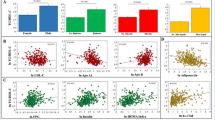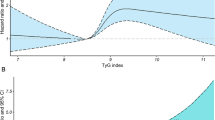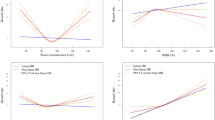Abstract
Objective:
Obesity promotes the development and progression of coronary heart disease (CHD), in part, through its association with hyperlipidemia, hypertension, clotting abnormalities and insulin resistance. We assessed whether these relationships persist in patients with established CHD treated with evidence-based preventive pharmacologic therapies.
Design and subjects:
We performed a cross-sectional study of 74 adults with CHD and a body mass index (BMI) of >27 kg m–2 (mean 32±4). The mean age of subjects was 64±9 years (range 44–84 years).
Measurements:
Obesity measures included weight, BMI, waist, fat mass, intra-abdominal fat and subcutaneous fat. Risk factor measures included insulin sensitivity, fasting insulin level, lipid profiles, blood pressure, C-reactive protein (hs-CRP), plasminogen activator inhibitor (PAI-1) and platelet reactivity. Medication use included aspirin (99%), statin (84%), β-blocker (71%), ACE inhibitor or blocker (37%) and clopidogrel (28%).
Results:
There was no direct relationship between obesity parameters and risk factor measures of lipid concentrations, blood pressure, clotting abnormalities or platelet reactivity except for a modest relationship between visceral fat and hs-CRP (r=0.30, P=0.02). However, increased BMI, waist circumference, fat mass, total abdominal fat and abdominal subcutaneous fat all correlated with insulin sensitivity (r-values −0.30 to −0.45, P-values 0.01 to <0.001) and insulin concentrations. Insulin sensitivity, in turn, was the best predictor of PAI-1, triglycerides, high-density lipoprotein (HDL) levels, cholesterol/HDL levels (all P<0.01) and platelet reactivity (R=0.34, P=0.02).
Conclusions:
Use of preventive pharmacologic therapies obviated the expected relationship between adiposity and CHD risk factors. However, a residual effect of insulin resistance is left untreated. Total adiposity and central adiposity were strong predictors of insulin sensitivity, which in turn predicted cardiac risk factors such as lipid concentrations, PAI-1 and platelet reactivity. Thus, while evidence-based pharmacologic treatments may diminish the statistical relationship between obesity and many cardiac risk factors, adiposity negatively impacts CHD risk by reducing tissue insulin sensitivity.
This is a preview of subscription content, access via your institution
Access options
Subscribe to this journal
Receive 12 print issues and online access
$259.00 per year
only $21.58 per issue
Buy this article
- Purchase on Springer Link
- Instant access to full article PDF
Prices may be subject to local taxes which are calculated during checkout


Similar content being viewed by others
References
Wilson PW, D'Agostino RB, Sullivan L, Parise H, Kannel WB . Overweight and obesity as determinants of cardiovascular risk: the Framingham experience. Arch Intern Med 2002; 162: 1867–1872.
Yusuf S, Hawken S, Ounpuu S, Bautista L, Franzosi MG, Cammerford P et al., INTERHEART Study Investigators. Obesity and the risk of myocardial infarction in 27 000 participants from 52 countries: a case–control study. Lancet 2005; 366: 1640–1649.
Ruige JB, Assendelft WJ, Dekker JM, Kostense PJ, Heine RJ, Bouter LM . Insulin and risk of cardiovascular disease: a meta-analysis. Circulation 1998; 97: 996–1001.
Despres JP, Lamarche B, Mauriege P, Cantin B, Dagenais GR, Moorjani S et al. Hyperinsulinemia as an independent risk factor for ischemic heart disease. N Engl J Med 1996; 334: 952–957.
Rana JS, Mukamal KJ, Morgan JP, Muller JE, Mittleman MA . Obesity and the risk of death after acute myocardial infarction. Am Heart J 2004; 147: 841–846.
Wolk R, Berger P, Lennon RJ, Brikalis ES, Somers VK . Body mass index: a risk factor for unstable angina and myocardial infarction in patients with angiographically confirmed coronary artery disease. Circulation 2003; 108: 2206–2211.
Rea TD, Heckbert SR, Kaplan RC, Pstay BM, Smith NL, Lemaitre RN et al. Body mass index and the risk of recurrent coronary events following acute myocardial infarction. Am J Cardiol 2001; 88: 467–472.
Rana JS, Nieuwdorp M, Jukema JW, Kastelein JJ . Cardiovascular metabolic syndrome—an interplay of obesity, inflammation, diabetes and coronary heart disease. Diabetes Obes Metab 2007; 9: 8–32.
Lee YH, Pratley RE . Abdominal obesity and cardiovascular disease risk: the emerging role of the adipocyte. J Cardiopulm Rehabil Prev 2007; 27: 2–10.
Cannon CP, Braunwald E, McCabe CH, Rader DJ, Rouleau JL, Belder R et al. Pravastatin or atorvastatin evaluation and infection therapy-thrombolysis in myocardial infarction 22 investigators. Intensive versus moderate lipid lowering with statins after acute coronary syndromes. N Engl J Med 2004; 350: 1495–1504.
Boden WE, O'Rourke RA, Teo KK, Hartigen PM, Maron DJ, Kostuk WJ et al., COURAGE Trial Research Group. Optimal medical therapy with or without PCI for stable coronary disease. N Engl J Med 2007; 356: 1503–1516.
Evans DJ, Murray R, Kissebah AH . Relationship between skeletal muscle insulin resistance, insulin-mediated glucose disposal, and insulin binding. Effects of obesity and body fat topography. J Clin Invest 1984; 74: 1515–1525.
Fujioka S, Matsuzawa Y, Tokunaga K, Tarui S . Contribution of intra-abdominal fat accumulation to the impairment of glucose and lipid metabolism in human obesity. Metabolism 1987; 36: 54–59.
Reaven GM . Banting lecture 1988. Role of insulin resistance in human disease. Diabetes 1988; 37: 1595–1607.
Ferrannini E, Balkau B, Coppack SW, Dekker JM, Mari A, Nolan J et al. Insulin resistance, insulin response, and obesity as indicators of metabolic risk. J Clin Endocrinol Metab 2007; 92: 2885–2892.
Ades PA, Savage PD, Brawner CA, Lyon CE, Ehrman JK, Bunn JY et al. Aerobic capacity in patients entering cardiac rehabilitation. Circulation 2006; 113: 2706–2712.
Bader DS, Maguire TE, Spahn CM, O'Malley CJ, Balady GJ . Clinical profile and outcomes of obese patients in cardiac rehabilitation stratified according to National Heart, Lung, and Blood Institute criteria. J Cardiopulm Rehabil 2001; 21: 210–217.
Tchernof A, Nolan A, Sites CK, Ades PA, Poehlman ET . Weight loss reduces C-reactive protein levels in obese postmenopausal women. Circulation 2002; 105: 564–569.
Schneider DJ . Abnormalities of coagulation, platelet function, and fibrinolysis associated with syndromes of insulin resistance. Coron Artery Dis 2005; 16: 473–476.
Savage PD, Banzer JA, Balady GJ, Ades PA . Prevalence of metabolic syndrome in cardiac rehabilitation/secondary prevention programs. Am Heart J 2005; 149: 627–631.
Toth MJ, Sites CK, Cefalu WT, Matthews DE, Poehlman ET . Determinants of insulin-stimulated glucose disposal in middle-aged, premenopausal women. Am J Physiol 2001; 281: E113–E121.
DeFronzo R, Tobin J, Andres R . Glucose clamp technique: a method for quantifying insulin secretion and resistance. Am J Physiol 1979; 237: E214–E233.
Fong Y, Matthews DE, He W, Marano MA, Moldawer LL, Lowry SF . Whole body and splanchnic leucine, phenylalanine, and glucose kinetics during endotoxemia in humans. Am J Physiol 1994; 266: R419–R425.
Bier DM, Arnold KJ, Sherman WR, Holland WH, Holmes WF, Kipnis DM . In vivo measurement of glucose and alanine metabolism with stable isotopic tracers. Diabetes 1997; 26: 1005–1015.
Allain CC, Poon LS, Chang CS, Richmond W, Fu PC . Enzymatic determination of total serum cholesterol. Clin Chem 1974; 20: 470–478.
Friedewald WT, Levy RI, Fredrickson DS . Estimation of the concentration of low-density lipoprotein cholesterol in plasma, without the use of the preparative ultracentrifuge. Clin Chem 1972; 18: 499–507.
Chmielewska J, Wiman B . Determination of plasminogen activator and its ‘fast’ inhibitor in plasma. Clin Chem 1986; 32: 482–485.
Macy E, Hayes T, Tracy R . Variability in the measurement of C-reactive protein in healthy subjects: implications for reference intervals and epidemiological applications. Clin Chem 1997; 43: 52–58.
Kabbani SS, Watkins MW, Ashikaga T, Terrien EF, Holoch PA, Sobel BE et al. Platelet reactivity characterized prospectively. A determinant of outcome 90 days after percutaneous coronary intervention. Circulation 2001; 104: 181–186.
Holmes MB, Sobel BE, Howard DB, Schneider DJ . Differences between activation thresholds for platelet P-selectin and glycoprotein IIb-IIIa expression and their clinical implications. Thrombosis Res 1999; 95: 75–82.
Trip MD, Cats VM, van Capelle FJ, Vreeken J . Platelet hyperreactivity and prognosis in survival of myocardial infarction. N Engl J Med 1990; 322: 1549–1554.
Thaulow E, Erikssen J, Sandvik L, Stormorkrn H, Cohn PF . Blood platelet count and function are related to total and cardiovascular death in apparently healthy men. Circulation 1991; 84: 613–617.
Froelicher Jr VF, Brammell H, Davis G, Noquera I, Stewart A, Lancaster MC . A comparison of the reproducibility and physiologic response to three maximal treadmill exercise protocols. Chest 1974; 65: 512–517.
Welk GJ, Slater CH, Green LW, Jones J, Thompson RW . A comparative evaluation of three accelerometry-based physical activity monitors. Med Sci Sports Exerc 2000; 32: S489–S497 pp.
Yesavage JA, Brink TL, Rose TL . Development and validation of a geriatric depression screening scale—a preliminary report. J Psychiatr Res 1983; 17: 37–49.
Smith SC, Allen J, Blair SN, Bonow RO, Brass LM, Fonarow GC et al. AHA/ACC; National Heart, Lung, and Blood Institute. AHA/ACC guidelines for secondary prevention for patients with coronary and other atherosclerotic vascular disease: 2006 update: endorsed by the National Heart, Lung, and Blood Institute. Circulation 2006; 113: 2363–2372.
Rosita GA, D'Agostino RB, Massaro J, Lipinska I, Mittleman MA, Sutherland P et al. Association between obesity and a prothrombotic state: the Framingham Offspring Study. Thromb Haemost 2004; 91: 683–689.
Rossouw JE, Lewis B, Rifkind BM . The value of lowering cholesterol after myocardial infarction. N Engl J Med 1990; 323: 1112–1119.
Malmberg K, Båvenholm P, Hamsten A . Clinical and biochemical factors associated with prognosis after myocardial infarction at a young age. J Am Coll Cardiol 1994; 24: 592–599.
Nissen SE, Wolski K . Effect of rosiglitazone on the risk of myocardial infarction and death from cardiovascular causes. N Engl J Med 2007; 356: 2457–2471.
Ross R, Dagnone D, Jones PJ, Smith H, Paddags A, Hudson R et al. Reduction in obesity and related comorbid conditions after diet-induced weight loss or exercise-induced weight loss in men. A randomized, controlled trial. Ann Intern Med 2000; 133: 92–103.
Fontana L, Villareal DT, Weiss EP, Racette SB, Steger-May K, Klein S et al. Caloric restriction or exercise: Effects of coronary heart disease risk factors. A randomized controlled trial. Am J Physiol Endocrinol Metab 2007; 293: E197–E202.
National Cholesterol Education Program (NCEP) Expert Panel on Detection, Evaluation, and Treatment of High Blood Cholesterol in Adults (Adult Treatment Panel III). Third Report of the National Cholesterol Education Program (NCEP) Expert Panel on Detection, Evaluation, and Treatment of High Blood Cholesterol in Adults (Adult Treatment Panel III) final report. Circulation 2002; 106: 3143–3421.
Conus F, Rabasa-Lhoret R, Péronnet F . Characteristics of metabolically obese normal-weight (MONW) subjects. Appl Physiol Nutr Metab 2007; 32: 4–12.
Ogden CL, Carroll MD, Curtin LR, McDowell MA, Tabak CJ, Flegal KM . Prevalence of overweight and obesity in the United States, 1999–2004. JAMA 2006; 295: 1549–1555.
Acknowledgements
This work was supported by NIH Grant RO1-HL72851 (P Ades PI) and the General Clinical Research Center, University of Vermont (UVM) College of Medicine (RR-109).
Author information
Authors and Affiliations
Corresponding author
Rights and permissions
About this article
Cite this article
Ades, P., Savage, P., Toth, M. et al. The influence of obesity and consequent insulin resistance on coronary risk factors in medically treated patients with coronary disease. Int J Obes 32, 967–974 (2008). https://doi.org/10.1038/ijo.2008.6
Received:
Revised:
Accepted:
Published:
Issue Date:
DOI: https://doi.org/10.1038/ijo.2008.6
Keywords
This article is cited by
-
The 223A>G polymorphism of the leptin receptor gene and lipid-lowering efficacy of simvastatin in Chinese patients with coronary heart disease
European Journal of Clinical Pharmacology (2009)



